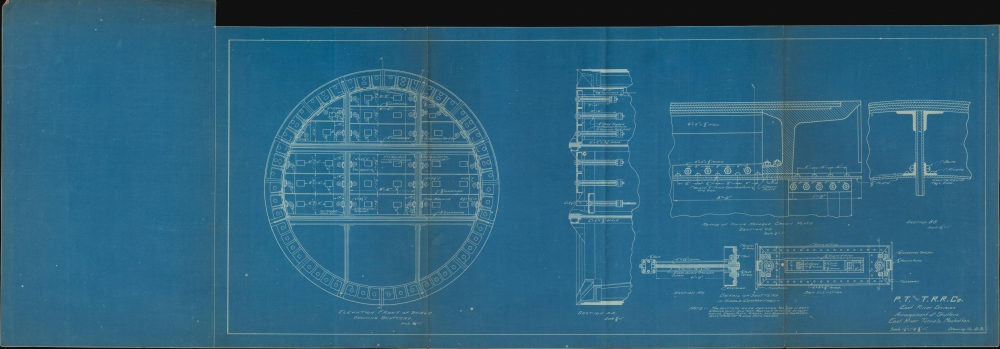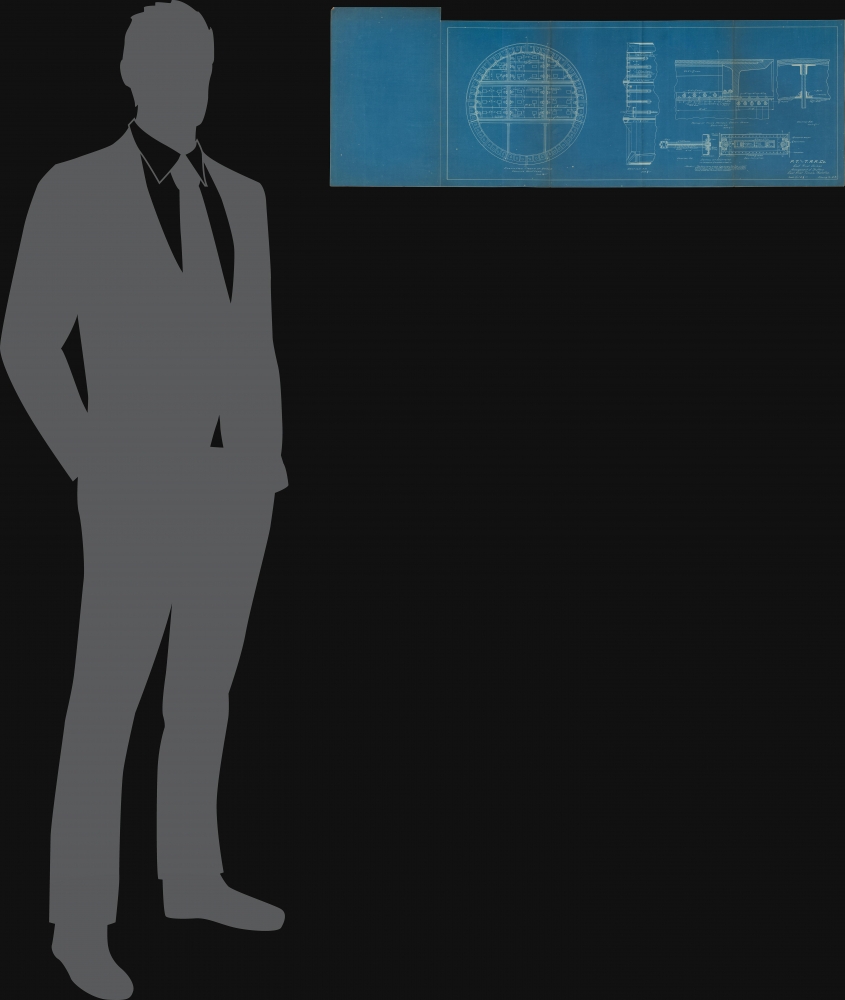1907 Original Blueprint of New York City's Pennsylvania Railroad East River Tunnels
EastRiverTunnels-ptandtrr-1907$750.00

Title
Arrangement of Shutters. East River Tunnels. Manhattan.
1907 (undated) 13 x 37 in (33.02 x 93.98 cm)
1907 (undated) 13 x 37 in (33.02 x 93.98 cm)
Description
A stunning c. 1907 blueprint cross-section of one of the East River Tunnels, constructed by the Pennsylvania Railroad in the first decade of the 20th century to connect to the glorious Beaux-Arts Pennsylvania Station ('old Penn Station').
Thus, the notion of rail tunnels under both the Hudson and East Rivers meeting at a station in Manhattan was born, though it took several years for ideas to be fleshed out and technology to catch up to make the plan practicable. After preparations were made for Pennsylvania Station in Manhattan, construction began on the tunnels in 1903.
Nevertheless, digging the tunnels was an ambitious and difficult undertaking. Tremendous amounts of equipment and labor were needed, and some of the methods used had not been tried out on such a large scale before. The 'sandhogs' who dug out the tunnels worked in dreary and dangerous conditions, and construction was so challenging, expensive, and deadly that work was frequently stopped to allow for adjustments and stopped almost entirely at one point in 1906. Nevertheless, between September 1906 and May 1908, all the tunnels under both rivers were completed, and by November 1910 passengers could travel from Long Island or New Jersey into Manhattan using the tunnels and exit at the beautiful Pennsylvania Station. Although the station was later controversially demolished in the 1960s, the tunnels continue to be utilized by Amtrak (successor to the Penn Railroad) and the LIRR today.
A Closer Look
The diagrams represent the construction and employment of shutters in the digging of the railroad tunnels under the East River. These mechanisms were attached to a massive shield that was 'shoved' to advance the tunnel at short intervals into the ground underneath the river. Two of these shields approached each other from opposite sides of the river for each tunnel. The shutters allowed for the separation of muck, gravel, and sand from sturdier material. The loose rock, quicksand, and mud then flowed down and backwards behind the shield into 'muck carts' on tracks in the already-completed portion of the tunnel, allowing them to be removed.The New York Tunnel Extension
The abbreviation in the title (P.T. and T.R.R. Co.) refers to Pennsylvania Tunnel and Terminal Railroad Company, that is, the company established by the Pennsylvania Railroad in 1907 by consolidating several of its subsidiaries that were impacted by an extension of the company's lines into Manhattan. Also known as the New York Tunnel Extension, this massive project aimed to connect Newark to the then-new Pennsylvania Station and then on to Sunnyside Yards in Queens. It was spurred by overall increased demand for rail transportation in and out of Manhattan, as well as the Penn Railroad's lack of such a service, as opposed to the New York Central's terminus at Grand Central Station. Meanwhile, the Long Island Railroad (LIRR) sought a means of bringing its service over or under the East River into Manhattan, and agreed to collaborate with the Penn Railroad.Thus, the notion of rail tunnels under both the Hudson and East Rivers meeting at a station in Manhattan was born, though it took several years for ideas to be fleshed out and technology to catch up to make the plan practicable. After preparations were made for Pennsylvania Station in Manhattan, construction began on the tunnels in 1903.
Nevertheless, digging the tunnels was an ambitious and difficult undertaking. Tremendous amounts of equipment and labor were needed, and some of the methods used had not been tried out on such a large scale before. The 'sandhogs' who dug out the tunnels worked in dreary and dangerous conditions, and construction was so challenging, expensive, and deadly that work was frequently stopped to allow for adjustments and stopped almost entirely at one point in 1906. Nevertheless, between September 1906 and May 1908, all the tunnels under both rivers were completed, and by November 1910 passengers could travel from Long Island or New Jersey into Manhattan using the tunnels and exit at the beautiful Pennsylvania Station. Although the station was later controversially demolished in the 1960s, the tunnels continue to be utilized by Amtrak (successor to the Penn Railroad) and the LIRR today.
Publication History and Census
This blueprint is undated, but the use of the initials for the Pennsylvania Tunnel and Terminal Railroad Company indicates a date later than June 1907. However, as the tunnels opened in 1910, the blueprint likely dates from the early part of the intervening period. This blueprint has no known history on the market and is not cataloged in any institutional collection.Condition
Very good. Wear and toning along fold lines.




